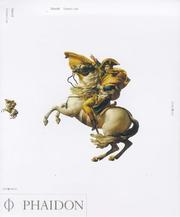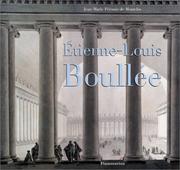| Listing 1 - 3 of 3 |
Sort by
|

ISBN: 0714838047 Year: 1999 Publisher: London : Phaidon,
Abstract | Keywords | Export | Availability | Bookmark
 Loading...
Loading...Choose an application
- Reference Manager
- EndNote
- RefWorks (Direct export to RefWorks)
More than any other artist, Jacques-Louis David (1748-1825) is identified with the dramatic upheaval of the French Revolution. As a liberal politician, he welcomed the promise of social change; as an artist he used his brush to glorify the Revolution's heroes and martyrs. When the political tide changed, David became Napoleon's chief painter, capturing the imperial pomp and contributing to the cult of military heroism. In this engrossing account Simon Lee argues that David was the single most important European painter of the age, perfecting a style of dramatic and noble painting that matched exactly the contemporary desire for morally elevating images. A leading exponent of what was to be termed Neoclassicism, he was, however, capable of departing considerably from its ideals of understatement and restraint. Lee's account is the first to trace all aspects of David's career, from his intellectual interests to his entrepreneurial skills and his relationships with patrons. Drawing on the most recent research, he analyses David's stylistic innovations, his political engagement, his search for new audiences, and his changing attitudes to the depiction of virtue and patriotism.
Aesthetics --- David, Jacques-Louis --- Neoclassicism (Art) --- Painters --- Art --- David, Jacques-Louis.
Book
ISBN: 9780300241204 0300241208 Year: 2020 Publisher: New Haven : Yale University Press,
Abstract | Keywords | Export | Availability | Bookmark
 Loading...
Loading...Choose an application
- Reference Manager
- EndNote
- RefWorks (Direct export to RefWorks)
"A study of the sudden emergence and decline of the empire style dress - characterised by sheer, white, high-waisted muslin dresses - in late 18th-century Europe, and its connection to wider cultural concerns of the period"-- The Age of Undress explores the emergence and meaning of neoclassical dress in the 1790s, tracing its evolution from Naples to London and Paris over the course of a single decade. The neoclassical style of clothing - often referred to as robe à la grecque, empire style, or "undress" - is marked by a sheer, white, high-waisted muslin dress worn with minimal undergarments, often accessorized with a cashmere shawl. This style represented a dramatic departure from that of previous decades and was short lived: by the 1820s, corsets, silks, and hoop skirts were back in fashion. Amelia Rauser investigates this sudden transformation and argues that women styled themselves as living statues, artworks come to life, an aesthetic and philosophical choice intertwined with the experiments and innovations of artists working in other media during the same period. Although neoclassicism is often considered a cold, rational, and masculine movement, Rauser's analysis shows that it was actually deeply passionate, with women at its core - as ideals and allegories, as artistic agents, and as important patrons.
Clothing and dress --- Women's clothing --- Clothing and dress. --- Women's clothing. --- History --- 1700-1799. --- Europe. --- Dress, Neoclassical --- Iconography --- History of civilization --- History of Europe --- anno 1700-1799 --- Neoclassicism (Art) --- Women --- Portraits --- fashion [concept] --- costume [mode of fashion] --- clothing --- kostuumgeschiedenis --- fashion [culture-related concept]

ISBN: 9782080100757 2080100750 Year: 1994 Publisher: Paris : Flammarion,
Abstract | Keywords | Export | Availability | Bookmark
 Loading...
Loading...Choose an application
- Reference Manager
- EndNote
- RefWorks (Direct export to RefWorks)
Architecture --- Neoclassicism (Architecture) --- Néoclassicisme (Architecture) --- History --- Histoire --- Boullée, Etienne Louis, --- Boullee, Etienne Louis, --- Criticism and interpretation. --- Catalogs. --- architectuur --- Boullée, Etienne-Louis --- 18de eeuw --- Classicisme (architecture) --- Néo-classicisme (architecture) --- Boullée, Etienne-Louis, --- Boullée, Etienne-Louis 1728-1799 (°Parijs, Frankrijk) --- Architectuur ; Classicisme ; Etienne-Louis Bouillée --- Architectuurtekeningen --- Architectuurprojecten --- 72.07 --- 741:72 --- Architecten. Stedenbouwkundigen A - Z --- Tekenkunst ; architectuurtekeningen --- Celebrities --- Photography, Artistic. --- Portrait photography. --- Portraits. --- architects --- court architects --- Neoclassical --- Néoclassicisme (Architecture) --- Boullée, Etienne Louis, --- Néo-classicisme (architecture) --- Boullée, Etienne-Louis, --- architectuur. --- Boullée, Etienne-Louis. --- 18de eeuw. --- tentoonstelling Luik (1893). --- Société Libre d'Émulation (Luik). --- oude meesters.
| Listing 1 - 3 of 3 |
Sort by
|

 Search
Search Feedback
Feedback About UniCat
About UniCat  Help
Help News
News